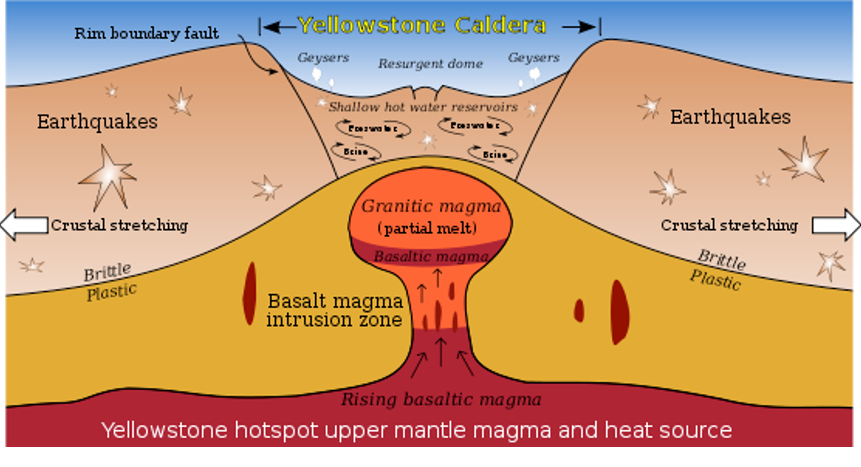VOLCANOES
1/48
There's no tags or description
Looks like no tags are added yet.
Name | Mastery | Learn | Test | Matching | Spaced |
|---|
No study sessions yet.
49 Terms
Volcano (What is it? Magma?)
•A volcano is a vent from which a combination of melted rock, solid rock debris, and gas is erupted
•Underlying active volcanoes is a reservoir of molten material, called a magma chamber (“Down below active volcanoes there is a large pocket of very hot, melted rock. That pocket is called a magma chamber, and the melted rock inside it is magma”)
•Magma is a mixture of molten rock, suspended mineral grains, and dissolved gas
Volcanoes and Temperature
•At Earth’s surface rocks begin to melt when heated to 800˚C-1000˚C, complete melting happens by 1200˚C
•Melting temperature depends on rock composition
•Pressure influences rock melting as greater pressures occur with depth and cause rocks to resist melting (like soda, open→ bubbles can come out)
•In contrast to the effect of pressure on melting, the presence of water dramatically reduces its melting temperature
Rocks deep underground are squeezed by the weight of everything above them. That squeezing (pressure) makes them harder to melt
Adding water to hot rock is like adding a melting helper: water makes the rock start to melt at a much lower temperature, so it becomes liquid more easily.
When temp increases enough causing part of the rock materials to melt and part to remain solid it becomes a partial melt or fractional melt.
→ Because almost all rocks contain a mixture of materials, they do not melt all at once at a single temperature; instead, there is a range of temperature and pressures in which they contain a mixture of melted and unmeted crystals. KNOWN AS INCONGRUENT MELTING.
This makes it possible for a melt of one composition to become separated from residual rock of a different composition.
→It means that when a rock partially melts, the liquid that forms (the melt) can end up having a different chemical makeup than the solid pieces left behind (the residual rock), and the melt can be physically separated from that residue.
→Heat causes part of a rock to melt, but not all minerals melt at the same temperature.
The minerals that melt go into the liquid (melt); the rest remain as solid residue.
If the melt moves away (flows upward, is squeezed out, or collects in a pocket), it becomes separated from the leftover solid material.
Now you have two materials with different compositions: the melt and the residual solid.
CN: Quenching with water cools magma so fast that crystals can’t grow, producing very fine‑grained or glassy rocks with microscopic or no visible crystals.
CN: The mantle, incapable of melting unless water is present (melt at a lower temp)
Magma
•Magma is less dense than the solid rock it formed from, so it rises
•Once magma starts to push its way up, pressure decreases (leaves more space for bubbles to expand), allowing decompression melting and the release of gases
•The process of ascent and the magma characteristics determine the eruptive style of the volcano
Nonexplosive Eruptions
•Characteristic of low-viscosity and low-dissolved gas content magmas
•Basaltic or Hawaiian-type eruption
•Pahoehoe and/or aa flow (pahoehoe cools down to Aa)
→Pahoehoe is hotter, more fluid, and forms smooth, ropy surfaces; as it cools, loses gas, or is deformed (stretched, sheared, or moves over steeper slopes), its viscosity rises and it can change into ʻaʻā, which is rough and clinkery.
•Vesicles due to trapped gas bubbles (has to be at surface)
→Vesicles are cavities left behind where gas bubbles were in the lava.
→As pressure drops when magma rises toward the surface, dissolved gases exsolve (come out of solution) and form bubbles. If the lava solidifies before the gas escapes, those bubbles are preserved as vesicles.
→Vesicles are most common in lavas that cool and solidify near or at the surface, but they can also form in shallow subsurface intrusions if pressure drops enough and bubbles are trapped before escape. If gas escapes completely before solidification, you won’t get vesicles.
Explosive Eruptions
•Viscous magmas have higher silica content, lower temperatures and higher dissolved-gas contents than basaltic
•Fragments of hot shattered magma or rock ejected during an explosive eruption is called a pyroclast
•A deposit of loose pyroclasts is called tephra
Eruption Columns
•Eruption columns form from a rapid drop in pressure causing gas-rich viscous magma to bubble violently like a shaken bottle of soda
•The hot mixture rises rapidly in cool air, driven by heat energy released by hot newly-formed pyroclasts.
→When gas‑rich, sticky magma suddenly loses pressure (like opening a shaken soda), the gas expands and tears the magma into lots of hot fragments. Those hot bits plus gas shoot upward as a tall, fast column because the mixture is much hotter and lighter than the surrounding air.
→It’s like a shaken soda bottle: open it (pressure drops), the gas expands and forces liquid out in a spray. In a volcano the “spray” is ash and pumice blown up into the sky.
Eruption Columns are cloud of super-heated ash and tephra suspended in gases that rises vertically during an explosive volcanic eruption.
CN:
Gas stays dissolved in liquid when the surrounding pressure is high. Drop the pressure and the gas wants out immediately (rapid decompression FORCES many tiny bubbles to form at once and grow fast)
→ it wants to tear the melt away instead of rising gently
→in contrast, increasing external pressure keeps gas dissolved + suppressed bubble growth (so more pressure does not make the liquid erupt, it prevents the eruption)
Flows and Blasts
•Pyroclastic flows (nuée ardente)
–Hot highly mobile tephra, denser than the atmosphere, among the most devastating
•Lateral blasts (e.g. Mt. St. Helens)
–Eruption blasting sideways as well as up
Mount St. Helens Eruption
•Largest historic eruption in North America
•Lowered peak by more than 400 m
•Destroyed all trees in a 400 km2 area
•Mudflows 29 km down Toutle River
•Ejected 1 km3 ash more than 18 km into stratosphere
The blast blew out the entire North flank of Mount St. Helen’s, leaving a gaping hole. In a brief moment, a prominent volcano was lowered by 1350 feet.
How can volcanoes be classified?
Volcanoes can be classified by location
•Subaerial (under air), submarine or subglacial
Or classified by shape
•Shield volcano, tephra cone or stratovolcano
Other volcanic landforms include
•Calderas and fissure eruptions
CN: Ash and Cinder are silica.
Stratovolcanoes
Rhyolitic and andesitic eruptions tend to eject large volumes of pyroclasts, building steep-sided volcanoes
The bigger stratovolcanoes are steep conical mountains consisting of layers of both lava and tephra
CN:
high silica so high viscous, so gases are trapped creating pyroclastic eruptions
Tephra (or Cinder) cones
INVOLVED IN INTRAPLATE VOLCANISM.
Are the simplest type of volcano. They are built from particles and blobs of congealed lava ejected from a single vent. As the gas-charged lava is blown violently into the air, it breaks into small fragments that solidify and fall as cinders around the vent to form a circular or oval cone
→A cinder (tephra) cone is the simplest volcano. It’s made when one spot on the ground (a single vent) spits out blobs and bits of lava. Those blobs cool in the air, fall back as little rocks called cinders, and pile up around the vent to make a round, steep cone.
Cinder cones can be active, but most are short‑lived: they erupt while they sit over a magma source (for example a hotspot) and usually stop erupting once plate motion carries them away.
Shield Volcanoes
Broad, roughly dome-shaped, basaltic
The biggest by size, but with surface slopes of only 5˚-10˚.
Mauna Loa is largest shield volcano
•9 km high
•Low angle slopes
•Well-developed caldera from collapse of magma chamber following eruption
→A caldera is a big bowl-shaped collapse that forms after a volcano blasts out a huge amount of magma. Once the underground magma chamber is emptied by the eruption, the roof above it can no longer be supported and it falls in, leaving a large, often circular depression.
CN:
Mid ocean→ makes shield volcanoes, made of basalt
Tall volcanoes with snow on top; can have snow on top even in tropical areas like Hawaii because it’s SO tall!
Volcanoes- Size Comparison (PHOTO)
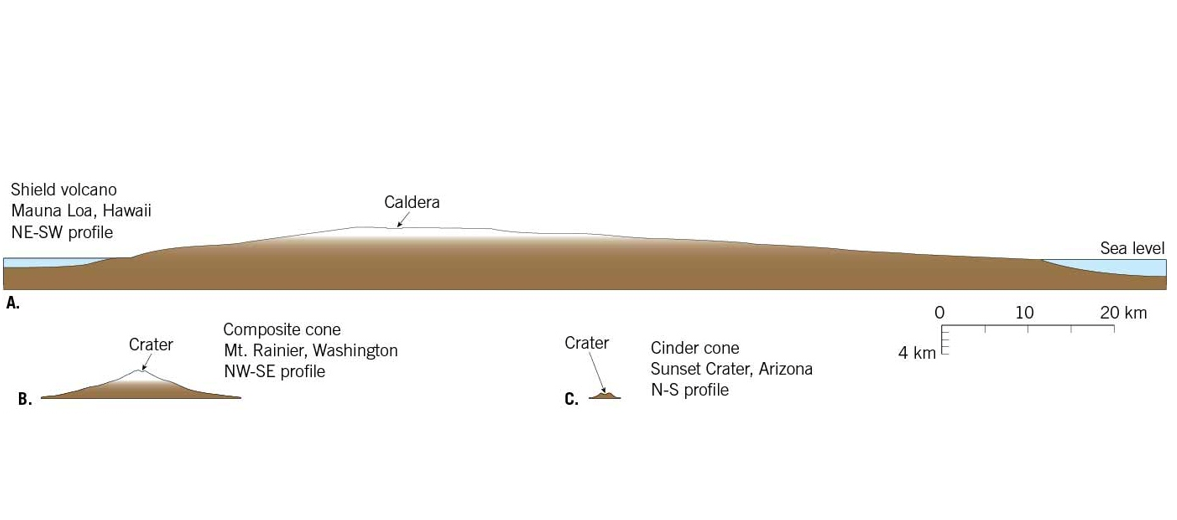
composite= stratovolcano
BIGGEST TO SMALLEST:
SHIELD → STRATO (COMPOSITE) → CINDER CONES

Kilauea (Hawaii)
•Quiet eruption of fluid basaltic lava
•Occasional lava sprays
•Eruption began in 1983 and has been ongoing for more than 20 years
Two types of basaltic lava flows:
→Aa
Rough, jagged blocks with sharp edges (surface cools and becomes a brittle and rough crust). SLOW
Cooler, more viscous basaltic flows
→Pahoehoe
Smooth, ropy surfaces
Hotter, less viscous basaltic flows
-fast
The Nature of Volcanic Eruptions
TEMPERATURE, COMPOSITION, AND AMOUNT OF DISSOLVED GAS AFFECT MAGMA BEHAVIOR.
Magma
•Molten rock containing crystals and dissolved gas
•Source material for volcanic eruptions
Lava
•Erupted magma
Viscosity
•Resistance to flow
Basaltic Magma
Generated by partial melting in upper mantle
At oceanic crust, erupts as highly fluid lava
At continental crust, collects at crust-mantle boundary
-Gases readily escape hot fluid basaltic flows, producing lava fountains. Although often spectacular, these features generally do not cause great loss of life or property.
Where magma reaches the seafloor (oceanic crust) it is usually very hot and low in silica, so it flows like runny syrup and spreads out easily.
→broad, thin lava flows and shield‑type features rather than steep volcanoes.
Under continents the crust is thicker and often cooler and more silica‑rich, so basaltic magma ascending from below can stall and pond where the dense mantle meets the base of the crust.
→the magma may pool, cool, partially crystallize, or evolve chemically before it can break through to the surface.
Fluid basaltic magma lets dissolved gases (like water vapor and CO2) bubble out easily as pressure drops near the surface.
Hot, runny basaltic lava holds dissolved gas when it’s deep underground. When it reaches the surface the pressure drops and the gas comes out of solution, forming bubbles that burst out of the lava and spray molten droplets into the air — those sprays are lava fountains.
→Because basaltic lava is very fluid, it usually moves relatively slowly and spreads out rather than exploding violently.
→Lava fountains and flows can cover land and damage buildings, but they rarely cause the fast, high‑pressure explosions or deadly pyroclastic flows that occur with high‑silica, gas‑trapped magmas.
Explosive Eruptions 2
Pressure decreases as magma rises
•Dissolved gas forms expanding bubbles
Viscous magma expels fragmented lava and gas
•Buoyant plumes of material (eruption columns)
→Viscous (thick, sticky) magma traps gas as it rises. When that trapped gas suddenly escapes, it shatters the magma into lots of hot fragments (ash, pumice, rock) and blasts them upward with the gas. That hot mixture of fragments and gas forms a rising, buoyant plume — an eruption column — that can shoot high into the sky.
Rapid ejection of magma
•Reduces pressure in magma chamber
•Causes further expansion and eruption
→With less pressure above it, the remaining gas in the magma expands more easily, which makes the magma push out even faster and can trigger more eruption.
Eruptions of highly viscous lavas may produce explosive clouds of hot ash and gasses called eruption columns.
Rhyolitic Magma
Wet melting of continental crust
•Explosive eruptions
•High gas content
Contains:
•Quartz, feldspar, hornblende, biotite, and muscovite
•Biotite and Muscovite contain water.
Partial melting of overlying continental crust generates less dense, silica-rich magma
Materials Extruded During an Eruption
•Gases in magma are volatiles
•~ 1–2% of total magma weight
•~ 70% water vapor, 15% carbon dioxide, 5% nitrogen, 5% sulfur dioxide, minor amounts of chlorine, hydrogen, and argon
•Contribute to atmosphere
→Significant quantities can alter global climate
Dissolved into magma because of confining pressure
Controls of magma viscosity
What dictates whether a volcanic eruption will be quiescent or explosive? (silica, temp, and how much gas in magma)
•Decreased temperature = increased viscosity
•Increased silica = increased viscosity
•Increased dissolved gases = more explosive
i.e. Gas escapes more easily in less viscous magma
The Nature of Volcanic Eruptions
Different compositions of magmas cause properties to vary

Materials Extruded During an Eruption
Particles erupted from a volcano
•Pyroclastic materials or tephra
•Ash and dust
•Hot ash fuses to form welded tuff
•Lapilli and cinders are pea- to walnut-sized pyroclasts
•Blocks are larger than 64 mm
•Bombs are streamlined blocks ejected while still molten
→bombs are molten projectiles shaped while flying
Scoria (used to soften clothes in stonewash) is mafic(low in silica so its dark and rich in Fe and Mg) vesicular ejecta; Pumice is felsic(high in silica, and lighter in color and thicker) equivalent
→Scoria is the bubbly, dark rock that forms when mafic (basaltic) lava bursts and traps many gas bubbles.
Pumice is the bubbly, light-colored rock that forms the same way but from felsic (silica-rich) lava.
Scoria is a vesicular rock commonly having a basaltic or andestic compositions. Pea-to-basketball size scoria fragments make up a large portion of most cinder cones (also called scoria cones)
Pumice is a low density vesicular rock that forms during explosive eruptions of viscous magma having andesitic to rhyolitic composition.
Pyroclastic Materials (tephra)
The term volcanic dust is used for fine volcanic ash under 0.063 mm (63µm)
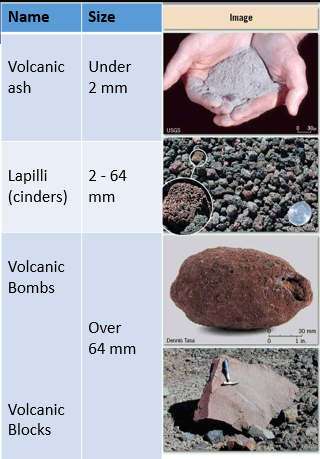
Volcanic Disasters
•Volcanoes that have erupted within historic times are called active (with magma underneath), those that exhibit signs of activity but have not erupted are said to be dormant (capable of waking, have not erupted), and those that appear completely dead are referred to as extinct
•In addition to the mid-ocean ridge volcanoes, there are at least 500 active volcanoes, most located around the Pacific
70 volcanic eruptions expected each year
One large-volume eruption each decade
500 million people live near active volcanoes
Volcano Hazards
•Tephra
•Acid rain (dissolved gases + H2O)
•Pyroclastic flow
•Lahar (mud/debris flow)
•Bombs
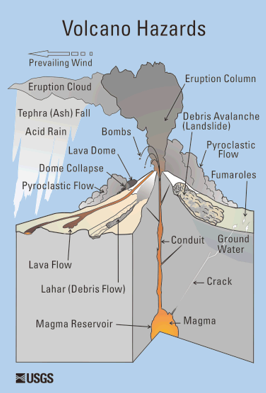
Pyroclastic flow
Pyroclastic flow (nueé ardente)
–Hot volcanic gas infused in incandescent ash and lava fragments
–Gravity driven, can move up to 100 km/hr
–Low-density cloud of hot gases and fine ash on top of layer of vesicular pyroclastic material
→(A hot, light cloud made of very fine ash and gases that sits above a thicker layer of chunky, bubbly volcanic rocks (the vesicular pyroclastic material). The cloud is low‑density because it’s mostly hot gas and tiny particles, so it can float or flow above the heavier pile of larger, holey fragments below)
Caused by collapse of eruption columns
Lahar (Mud and Debris Flows)
Fluid mudflows
Water-saturated pyroclastic materials move down steep volcanic slopes
•Upper Deposit: Block and ash flow (effusive; flowing lava rather than explosive ash and rock)
•Lower deposit: pyroclastic (explosive) – finer particles and pumice.
→water makes hot volcanic debris flow downhill like a wet slide; the heaviest chunks fall out first (block‑and‑ash), and the lighter pumice and ash settle later to form the finer pyroclastic layer.
Can occur when a volcano is not erupting. Deposits are unstable and heavy rain can dislodge them.
→Deposits are the piles or layers of material left behind after a volcanic event.
CN: Sediments and Volcano
Long time for sediments to become rock
Volcano erupts, erupts sediments + those sediments can be carried by water (river clogged with sediments + trees _ debris, making it powerful, and it dries as a cement later on)
Volcanic Hazards 2
Ash (hot combination, pulverized rock, fine grains silica (fine deposits; can be found in ice cores because it distributes globally in the sky)
–Can damage buildings, living things, aircraft engines
Sulfur dioxide (cools atmosphere, not a greenhouse gas)
–Affects air quality and creates acid rain
Tsunamis (seismic ocean wave occurs with large displacement; “big splash” is when portion of volcanoes falls into the ocean and causes earthquakes)
–Caused by collapse of volcano flanks into the ocean
Atmospheric cooling
–Ash and aerosols reflect solar energy
Volcanic Disasters 2
Hazards from stratovolcano, and felsic eruptions in general, occur as
•Hot, rapidly moving nuée ardentes and lateral blasts
•Tephra and hot poisonous gases bury and suffocate
•Tephra + rain = lahar (deadly mudflow)
•Violent undersea eruptions cause tsunamis
•Tephra destroying agricultural land and cities
CN:
fine grained silica powder (not soft, LOOKS like regular ash; scratchy, can be distributed by large distance. Has a lot of surface area by mass, more contact with water quickly)
→fine, weathered silica that is chemically reactive weathers faster, can react with water and transform to clay minerals; but if the fine silica is crystalline quartz, it mostly stays silica and only becomes sediment (loose grains) rather than clay
Felsic eruptions come from silica‑rich, sticky magma that traps gas and explodes violently, sending ash, pumice, and hot gas high into the sky
Volcanic Disasters 3
Long term predictions of volcanic eruptions is based on geologic history
To some extent volcanic hazards can be anticipated as well
Common signs of an imminent eruption are swarms of small earthquakes or sudden changes in the amount or composition of gases being emitted from the volcano
Affecting global circulation: ash circulated significantly, causing for cooling of atmosphere seen in the freezing points of tree ring growth)
Origin and Distribution of Magmas and Volcanoes
Mid-ocean ridges, hotspots and basaltic magmas
-Sourced by molten mantle material
-Partial melting due to decompression
→the mantle rises and pressure drops, causing partial melting and making basaltic magma (HIGH PRESSURE, INSIDE THE EARTH, KEEPS THE ROCKS SOLID BUT AS THE ROCK/MANTLE RISES, THERE IS LESS PRESSURE WHICH CAUSES PARTIAL MELTING)
→mid ocean ridge: submarine basaltic pillow lavas
→ hotspot: shield volcano developed above hot spot, basaltic lava flow
Continental rifts and rhyolitic magmas
-Confined within continental crust
-Partial melting of silica-rich continental crust
→ 80% silica (silica rich and happen under continents; incorporated continent material in melting → Yellowstone +Africa)
Subduction zones and andesitic magmas
-Ocean-ocean and ocean-continent subduction zones have high water content and undergo wet melting
-Magma forms in the mantle and rises up through overlying crust
→ ocean-continental subduction zone: andesite flows and pyroclastics
→clay minerals carry down water with them (get soaked in water)
→ ocean- ocean subduction zone: andesite flows and pyroclastics
Sills and Dikes – Intrusive Features
Magmatic Intrusions
•Dike – vertical feeder
•Sill – horizontal feeder (in between strata)
→surrounding material weathered away leaving behind the intrusion
→sediments rocks are soft compared to igneous (often weathers slowly)+ metamorphic rocks
→ glaciation wiped minerals out of the way
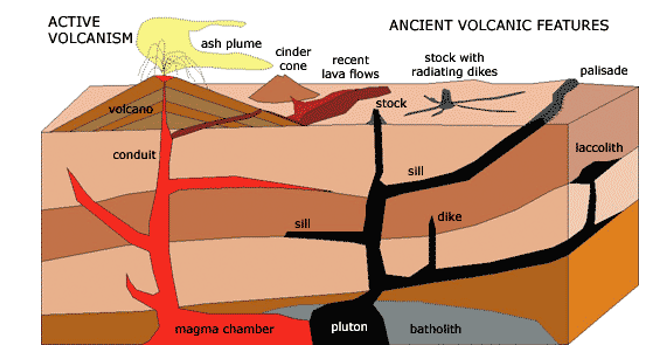
Intrusive Igneous Activity
Large intrusive bodies include:
•Batholiths
→Linear masses of felsic rocks hundreds of km long
•Stocks
→Surface exposure < 100 km2
•Laccoliths
→Lift the sedimentary strata that they penetrate
Cool within crust and displace existing rock
Exposed by uplift and erosion
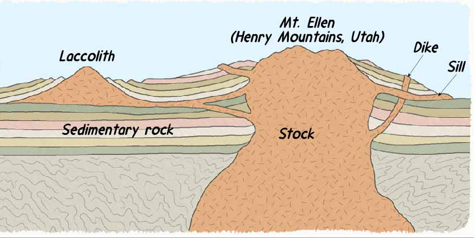
Volcanic Features: Calderas
Caldera (from latin caldaria = cooking pot)
•A large collapsed depression with a more or less circular form.
•Steep-sided crater less than 1 km in diameter
•Can form from collapse of top of a shield volcano (Hawaii-type), explosive eruptions (Crater Lake-type), or colossal collapse (Yellowstone)
Active, with occasional lava lake.
Subsidence due to draining of the chamber along lava tubes.
→This means the volcano is still alive and sometimes has a pool of molten lava sitting in its crater or vent. The lava lake is a small, standing body of hot, flowing magma you can sometimes see glowing inside the volcano.
→When lava leaves the underground magma chamber through narrow tunnels called lava tubes, the chamber loses support. As the chamber empties, the ground above can sink or collapse a little — that sinking is subsidence. In short: lava flows out through tubes, the underground chamber gets partly emptied, and the surface drops down as a result.
Crater Lake, Oregon
Catastrophic eruption of Mount Mazama; largest of Cascade Range. 7kya
10 km diameter
Other Volcanic Landforms
Fissure eruptions
•Emit basaltic lavas from fissures (fractures)
Basalt plateaus
•Flat, broad accumulations of basalt emitted from fissures
Flood basalts (catastrophic events→ can cause large amounts of carbon dioxide)
•Molten lava having flowed long distances within a basalt plateau
→very fluid, hot lava moved far across the landscape and spread out to build a wide, flat area made of basalt rock.
Other Features
•Calderas, volcanic necks, pipes
Intrusive Igneous Activity: Columna Jointing
•Columnar jointing occurs as a result of shrinkage fractures that develop when igneous rocks cool
→Columnar jointing means that when a thick body of molten rock (magma or lava) cools and solidifies, it shrinks and cracks in a regular way that produces long, mostly hexagonal columns of rock, like a stack of vertical pillars.
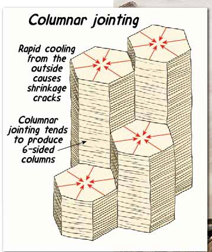
Plate Tectonics and Volcanic Activity: Intraplate volcanism
Intraplate volcanism
•A mantle plume of hot material ascends to the surface
CN:
context of flood basalt→ to birth a new ocean: HOTSPOT swelled up, breaking creates normal breaking (pushing plates apart)
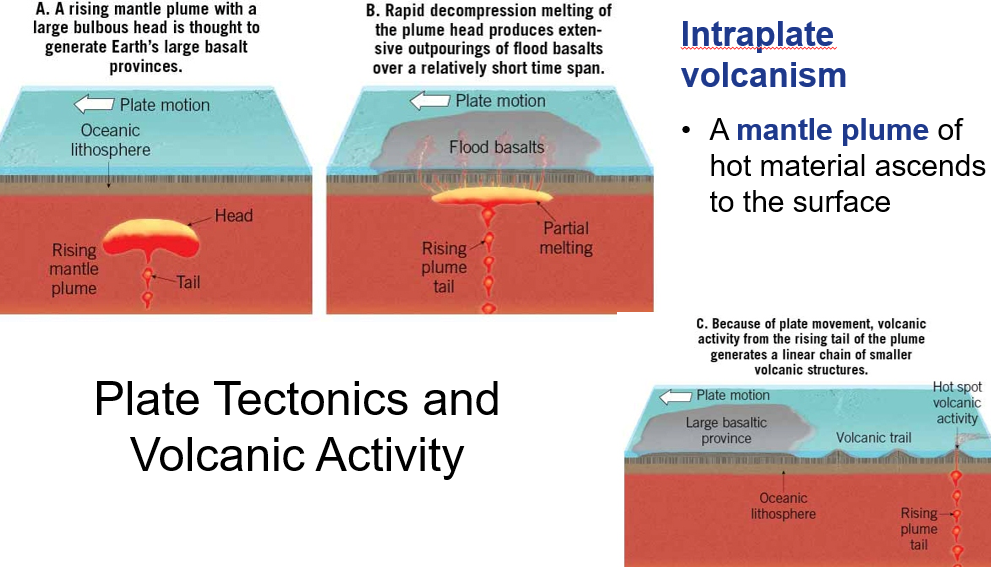
Yellowstone Eruption
Supervolcano – 630,000 years ago
Caldera diameter: 70 kilometers (43 miles)
How do they form?
•Magma chamber near the surface (melts continental crust); silica rich (likes to polymerize; more silica= more viscosity); gases build up
→There’s a shallow underground tank of thick, sticky magma that has a lot of dissolved gas trapped in it. Because the magma is silica‑rich it’s gooey, so gas can’t escape easily and pressure increases until it’s released violently
•Ring fractures near roof of the chamber
→When pressure gets high, the roof of that magma tank cracks in a circular pattern. Those round cracks let the magma and gas blast out through the top
•Huge volumes (100 cubic km) of pyroclastic material at 100 kph
→When the blast happens it can throw out an enormous amount of hot ash, pumice, and rock fragments — imagine a pile as big as 100 cubic kilometers — and that material can race outward at speeds around 100 kilometers per hour, destroying and burying anything in its path
•Hot fragments fuse together to form welded tuffs
→The ejected hot pieces are so hot and packed so closely that they can stick and weld together when they settle, forming a hard rock called welded tuff
•Loss of support causes the roof to collapse
-After the chamber empties a lot of its internal support is gone, so the ground above falls in, forming a large, sunken crater called a caldera
→steam releasing is good because it relives pressure
Impact of Large Tephra Deposit
Devastating to Vegetation and Climate
The Yellowstone eruptions spread volcanic ash over large parts of the North American continent, covering up to 1/3 of the continent with silicate ash of at least 10 cm depth.
Yellowstone’s future
3 Large eruptions in the last 2.1 Ma
Next few 100 years – hydrothermal eruptions and moderate to large earthquakes (currently between 1000-3000 occur per year.
Volcanoes-Climate Connection
Short and long-term
–“Nuclear” Winter:
•after Pinatubo erupted in 1991 – cold temperatures ( 1 ºC drop in global temps for 2 years)
•Tambora in 1815 – caused crop failures and famine in N. America and Europe
–Gases and particles may warm or cool the earth’s surface, depending on how sunlight interacts with volcanic material
–Fine dust causes cooling; Some gases cause warming, some cause cooling.
→ winds will distribute evenly so the cooling will be globally
→ volcanoes→ fine grain of silica have more magnitude and travel far
Pinatubo and Tambora: Sulfur haze – cooling
Flood basalt – enough CO2 to cause warming
CN: Basalt
Dark rock, 50% silica, “river’ of molten rock. Low viscosity, runny
CN: Intro to Volcanoes
Heat causes stretching land and the heat makes the land rise (makes the land more buoyant). When it cools, it becomes dense and dark. And it goes through contact/thermal metamorphized sediments: rocks altered by heat from nearby magma or lava rather than pressure or tectonic forces. Temp is high enough to recrystallize minerals.
DIFF METAMORPHISM (2):
CONTACT/ THERMAL METAMORPHISM: Driven by heat from local igneous body and affects a narrow zone
-contact metamorphism usually produces non-foliated rocks (marble, hornfels)
REGIONAL METAMORPHISM: driven by high pressure and temp over wide areas DURING tectonic collision and produces foliated rocks (schist and gneiss)
Foliated rocks have visible layers or aligned minerals that make them look banded or flaky but nonfoliate do not show layering, they look blocky, uniform or crystalline
When you break the seal→ magma and bubbles flow.
When magma cools down… it will solidify and crystalize (into whatever is table at that temp + pressure)
→Under is called “magma”
→” Lava” is what it’s called at the surface.
Progression of increasing in silica when it crystalizes. (Increasing crystallization (especially when crystals are removed from the melt) generally leads to an increase in silica concentration in the residual melt, which changes mineralogy, raises viscosity, and often makes eruptions more explosive)
→ increase in crystallization, increases silica, making it more silica rich
CN: Crystallization and Silica
Viscosity increases as silica rises because silica promotes polymerization of the melt (long Si–O chains). Higher viscosity slows gas escape and flow.
Eruption style shifts toward more explosive eruptions with higher-silica magmas (dacite/rhyolite) because trapped gases build pressure.
Mineralogy changes: low‑silica magmas crystallize olivine and pyroxene; higher‑silica magmas crystallize more feldspars (especially alkali feldspar) and quartz at the end of crystallization.
Basalt (low SiO2, low crystallization of silica minerals) → fractional crystallization removes mafic minerals → Residual melt becomes andesitic → dacitic → rhyolitic (high SiO2, high viscosity, quartz/feldspar crystallize last).
If a basaltic magma cools and 30–50% of its mass crystallizes and those crystals settle out, the remaining melt may have enough silica enrichment to behave like an andesite rather than a basalt.
Increasing crystallization (especially when crystals are removed from the melt) generally leads to an increase in silica concentration in the residual melt, which changes mineralogy, raises viscosity, and often makes eruptions more explosive.
CN: Mantle Melting
Mantle made of peridotite→ melting makes basalt (but melts only things that can melt; needs to refertilize diorite, what’s left over is mostly olivine)
→ recycled through SUBDUCTION (carries basalt, water + sediment (on ocean floor; not ALL of it melts as it experiences high pressure and endures metamorphosis)
→ Refertilzing the mantle → so a progressive increase in silica (rocks that are light and have less Fe + Mg) with each step of melting.
CN: VOLCANO →
→tephra
→ actual sediments (of igneous deposits)
Palisades- Watchung System
pattern with mass extinction and flood basalt.
The Palisades–Watchung System is a group of related early Mesozoic igneous rocks formed during rifting of eastern North America about 200 million years ago.
The rocks form distinctive cliffs and ridges used as local building stone and as field examples for studying shallow intrusions and flood basalts
Flood Basalts- Oceanic Plateaus and Continental Flood Basalts
Ex(s):
Ontong-Java Plateau, Caribbean plateau, Siberian Traps, Deccan Traps, CAMP, Parana Basalts, Columbia River Basalts, Kerguelen Plateau
The Yellowstone caldera
stretching makes inward facing faults
Break the sela and the bubble come out
